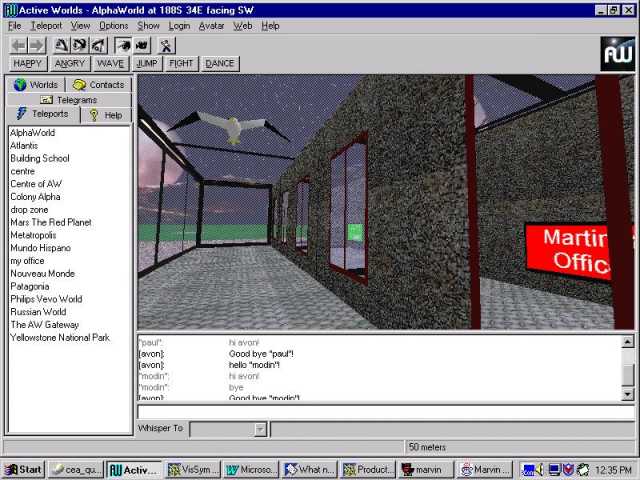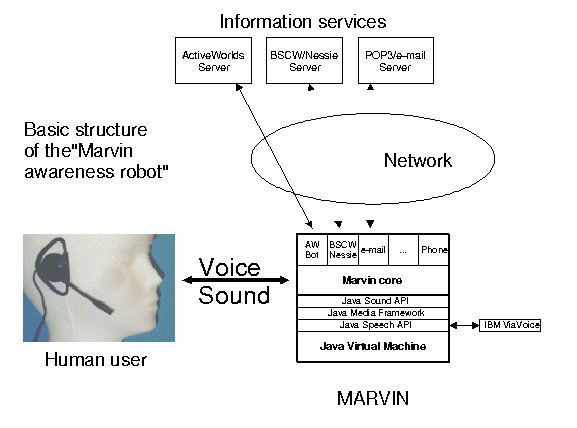Such concerns, however, also point to a larger issue. Unlike many virtual activities (such as gaming or training simulations) collaborative working requires that one has a variety of presences - of awarenesses. One can be both in a physical office and engaged in a telephone conversation: in this situation where is one's presence? It seems to be in both 'places' at once.
The problems of missed encounters were addressed by the addition of audio cues, so that activity in the virtual world generates various appropriate sounds that can be heard when the user is unable to view the 3D world. A user can set up avatar representations in a number of locations in the virtual world, each one specific to an ongoing work task of interest. While otherwise engaged, this user can now follow much of the 'coming and goings' and other activity that is taking place in all of these locations. The identity of which location the action occurs being indicated by variations in the sound cue.
One of the surprising results is that moving away from a purely visual presence to an auditory one creates new possibilities of presence. Specifically, we have extended the system to allow for multiple 'proxy' avatars in various spaces. This would be impracticable with a conventional visual interface - one window only on the virtual world takes up enough screen real estate, multiple windows would make other work impossible.
It seems strange that as technology in the workplace tries to liberate us from being fixed to a single location, through the use of mobile for, for example, that collaborative virtual environments should try to re-impose that constraint. The use of audio, and its ability to carry multiple steams, allows us to exploit the potential of VR technologies and support partial presence in many locations at the same time. With this in mind, we have extended the audio features of AlphaWorld. A user can now work in the physical office, and need not even have the 3D-world window on-screen. They can set a number of probes, or proxies, of their avatar in a variety of places. Each place in the environment is associated with particular content, in that the various object in the location are hyperlinked to online content which is stored in BSCW. Most work consists of managing a number of tasks at the same time, dealing with a variety of projects. Just consider a typical day: writing a document, while reading and responding to new emails, phoning a colleague about an urgent problem, and so on. The AlphaWorld virtual office that we use follows this idea, creating task-related rooms and buildings in a larger social community.
Each proxy is a bot that generates suitable audio cues for important activities at each location, such as another user entering or leaving, another user text-chatting, or a hyperlinked object being activated. This audio bot system is called Marvin. Figure 1 shows a screen shot from the AlphaWorld office, one of the proxy bots is in the space, represented by the avatar of a bird (this avatar was selected from the limited number available in AlphaWorld due to its connotation of being somewhat 'above it all', of partial presence).

Figure 1. A Marvin proxy in the Virtual Office
2. Marvin: an auditory bot
The Marvin bot is a simple programmable agent, who can enter multiple information servers (such as AlphaWorld) as a proxy and report noteworthy events via speech and audio to the user. Since with the help of the robot one is constantly aware what is going on, he can if desired then directly turn his attention to the appropriate application and enter the locale instead of the robot. The proxy itself isn't an independent intelligent agent, it is an extension to the user's senses for extended awareness of events in info-space.Marvin is implemented in the Java programming language, version 1.1 or above. This decision was made mainly because of Java's platform independence and the availability of various multimedia features like Speech, Sound, and Media APIs. The application consists of two layers:
1. The Marvin core classes, which provide the basic features like speech recognition and synthesis, sound
output, logging and so on. This core loads all present plug-ins after initialisation and starts them as
independent threads. The plug-ins then can use Marvinís event processing methods. Depending on the eventís
priority, it will either only logged to a file or to the screen, or in case of the highest priority announced
with speech and audio cues.
2. The plug-in interface, which allows the easy addition of any information service. At the moment we have
only implemented an Active Worlds Robot. But due to this architecture and the fact that Marvin is released
under the GPL (Gnu General Public License) it is easy for third party developers to add their own plug-ins for
various other network information services or multi-user environments.

2.1 The Active Worlds Robot
The AWBot plug-in uses Thierry Nabeth's Java native interface for the Active Worlds Software Development Kit. Applications implementing this interface can place a remote-controlled avatar into the Active Worlds space, which can interact with other persons or events in this virtual environment. Once such a robot is placed in a certain predefined area of a world within the AW server, it will notice any event in its surroundings. These events are then caught be the robot application, analysed and then processed by the Marvin core according to their priority. Since, as mentioned above, a robot only can notice events in its nearest surroundings, multiple instances of the robot - called probes - were created and placed in various areas of the AW space. To ease the modification of the robots, all the variable parameters such as position, user names or sound files are stored in separate configuration files that are processed upon start-up.
3. Discussion
We have used readily available Internet 3D world technologies to explore the use of desktop VR for collaborative working applications for some years now. Throughout that time one issue constantly arises. The technology has been primarily developed for certain simulation tasks, for training and gaming. The notions of immersion and presence which are appropriate for such applications differs greatly from the needs of CSCW (computer-supported collaborative working) in which the virtual environment is part of ongoing work activities. Indeed, it may be better to consider such systems as a form of augmented reality, as users always require 'one foot in the physical world'.Experience of the use of the audio bot system has confirmed many of our intuitions: Not only of the importance of multiple presence, but of the power of the audio channel. The response to sound is so very different to that of visual information. A virtual doorbell sounds like a physical one - both has the same form of waves in air hitting the ear. A virtual visual door image, however, does not yet have that same equality of experience. In future work we hope to explore what the nature of this audio mediated presence. Two possible factors seem worth investigating. Firstly, the role of social presence (as discussed by Towell & Towell 1997), that is, to what extent is a sense of being there sustained by the possibility of interaction with other (interesting) users. Or secondly, could it be that the use of audio changes the nature of the space. In our own experience is seems as if the various locations which contain proxies are rooms next to my physical office. Just as I can overhear activity in physical rooms next to my own office, so it is with the virtual rooms. They often feel alike, as if both forms of space are in constellation around a primary physical location. It is hoped that extended use of the system will address which of these, or other factors, are crucial.
Acknowledgements
The authors would like to acknowledge the efforts of Thierry Nabeth of the Department of Technology Management at the Centre for Advanced Learning Technologies, INSEAD, France. His Java port of the AlphaWorld SDK made the Marvin system possible, and his speedy updates from our comments were invaluable.
Bibliography
Backhouse, A. & P. Drew (1992) The Design Implications of Social Interaction in a Workplace Setting.Environment and Planning B: Planning and Design, 19: 573-584.
Huxor, A (1999) The Role of 3D Shared Worlds in Support of Chance Encounters in CSCW.
In: Vince, J. & Earnshaw, R. (eds.) Digital Convergence: The Information Revolution. Springer-Verlag
Towell, J. & Towell, E. (1997) Presence in Text-Based Networked Virtual Environments or "MUDS" Presence 6(5) 590-595.